Dalia, Israel
Dalia (Hebrew: דַּלִיָּה) is a kibbutz in northern Israel. Located in the Galilee about 30 km southeast of Haifa, it falls under the jurisdiction of Megiddo Regional Council. The kibbutz was established in 1939. As of 2021 it had a population of 844.[1]
Dalia
דַּלִיָּה | |
|---|---|
 | |
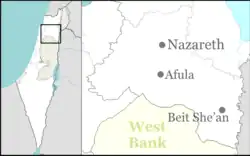 Dalia  Dalia | |
| Coordinates: 32°35′25″N 35°04′39″E | |
| Country | |
| District | Northern |
| Council | Megiddo |
| Affiliation | Kibbutz Movement |
| Founded | 1 May 1939 |
| Founded by | Hashomer Hatzair |
| Population (2021)[1] | 844 |
| Website | www |
History
Kibbutz Dalia was founded by members of two Jewish groups affiliated with the Hashomer Hatzair movement who moved to Mandatory Palestine in 1933. The first group was called "Ba-Ma'ale" (Hebrew: "במעלה") and was composed of Romanian Jews. They underwent agricultural training in Romania before making Aliyah and settling in Hadar Ramatayim, Magdiel (now part of Hod HaSharon) and Kfar Malal. The other group was called "Ba-Mifneh" (Hebrew: "במפנה") and was composed of German Jews. Their agricultural training took place mostly in Denmark but also in France and the United Kingdom. They settled in Karkur and earned a living from agriculture, construction and labor in the Port of Haifa. The Kibbutz Artzi network of the Hashomer Hatzair movement has decided to unite the groups in April 1939 and the two were symbolically united on 1 May (International Workers' Day).[2] That same day 50 members, 25 from each group, arrived at the permanent location of the settlement,[3] next to the Arab village of Daliat-El-Ruha (depopulated in 1948)[4] and began cultivating the land which was owned by the Jewish National Fund (KKL). The first industry of the kibbutz was a small soap factory.[3]
The 1940s saw major developments in the kibbutz. Between 1940 and 1943 a stable, cowshed (used until 1970), a pen, cheese factory, a textile factory, a chicken coop (used until 1973) and a beehive were built. A road was paved by the members from the nearby kibbutz of Ein HaShofet, connecting it to the rest of the country's transportation system. The first permanent building was a house, which housed the kibbutz' babies. In the 40s the kibbutz also had a rabbit farm, which was the main source of meat during the austerity period of World War II.[3]
In 1944 youth from the kibbutz organized a group, which later joined the Palmach militia. One of their members died in the "Night of the Bridges", an operation by the Jewish militias against bridges on the borders of Mandatory Palestine. They fought with the Yiftah Brigade during the 1948 Arab–Israeli War and some of them established Kibbutz Harel. In 1947 the kibbutz housed a nationwide squad leader course for the Palmach. During the war, an Egyptian plane was downed near the kibbutz and its pilot was caught and put in the kibbutz' cowshed, which drew the children's attention. The kibbutz helped the war effort by donating its only truck and also using the local facilities to help Israel's military industries.[3]
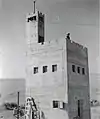 Dalia 1940
Dalia 1940 Dalia 1943
Dalia 1943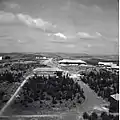 Dalia 1944
Dalia 1944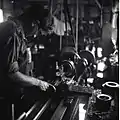 Dalia workshop 1944
Dalia workshop 1944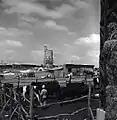 Dalia dairy 1944
Dalia dairy 1944 Yiftach Brigade 1st Battalion, "D" Company, roll-call, Dalia. 1948
Yiftach Brigade 1st Battalion, "D" Company, roll-call, Dalia. 1948
Culture
Cultural and communal activities flourished in the kibbutz. A folk-dancing festival organized by Gurit Kadman in 1944 was held at the "Khan" on the kibbutz during the festival of Shavuot. The Book of Ruth (Megilat Ruth) was the theme of the festival, and residents of the various settlements in this region took part.[5] Among the participants was Yemeni Jewish Sara Levi-Tanai, who founded the Inbal Dance Theater company in 1949. The festival lasted for two days, with 200 dancers and 3,000 viewers.[3] Three years later, in 1947, a second dance festival was held in the natural amphitheater beside the kibbutz. At this festival, several hundred dancers participated, watched by some ten thousand people from all over the country.[5] Kibbutz theatre director Shulamit Bat-Dori directed the last two dance festivals held at Kibbutz Dalia, in 1958 and 1968.[6][7] The 1958 production spotlighted 1,500 dancers, while the 1968 festival featured 3,000 dancers and attracted 60,000 audience members.[6]
See also
- Dance in Israel
- footage of folk dance festival 1940s at Kittutz Dalia from Fred Monosson archive
References
- "Regional Statistics". Israel Central Bureau of Statistics. Retrieved 22 February 2023.
- "History - Genesis". Kibbutz Dalia website (in Hebrew).
- "History". Kibbutz Dalia website (in Hebrew).
- Morris, Benny (2004). The Birth of the Palestinian Refugee Problem Revisited. Cambridge: Cambridge University Press. pp. 131-2. ISBN 978-0-521-00967-6.
- Spiegel, Nina S. (2013). Embodying Hebrew Culture: Aesthetics, Athletics, and Dance in the Jewish Community of Mandate Palestine. Detroit: Wayne State University Press. p. 7. ISBN 9780814336373.
- Ingber, Judith Brin (2011). Seeing Israeli and Jewish Dance. Detroit: Wayne State University Press. pp. 166–167. ISBN 978-0814333303.
- Goren-Kadman, Ayala (1 March 2009). "Ethnic Dance in the Yishuv and Israel: 1900-2000". Jewish Women: A Comprehensive Historical Encyclopedia. Jewish Women's Archive. Retrieved 1 January 2017.